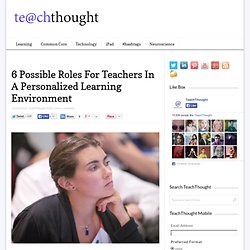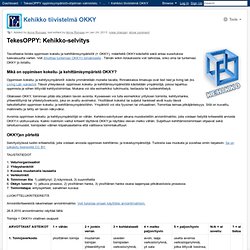

Personal Learning Environments. Tutkittua_tietoa_oppimisymparistoista_VERKKO. 6 Possible Roles For Teachers In A Personalized Learning Environment. By Justin Marquis, Ph.

D There is a mountain of speculation and debate about what school and learning will look like in the near future. Will education be online? Individualized? Self-paced? The Future of Learning An October, 2012 video released by telecom company Ericsson presents a survey of educational experts and entrepreneurs speculating about the future of education. The focus of the video is the ability of these technologies to track minute user data and facilitate intimately individualized instruction based on that data, including student learning preference, peak performance times, prior knowledge, and a host of other information. “Coursera’s Koller says one of the revolutions in education is that teaching will be less about conveying information and more of a return to its original roots where instructors engage in dialogue, develop critical thinking skills and spark passion about a discipline.” (23 Oct., 2012) The Role of the Educator on an Individualized World?
1. 2. 3. How Digital Platforms Are Disrupting How Learning Happens. Media is becoming increasingly digitized, and we learn through, among other processes, consumption of media.

It makes sense then that digital platforms just might be changing the way learning happens. A “platform” can be defined as an app, a website, an eLearning environment, or a collaboratively curated content source. 6 Examples Of Digital Platforms 1. Apps: Phonics Genius, Frog Dissection, Google Earth 2. 3. 4. eLearning Environments: Khan Academy, Coursera, MOOCs in general. Taitoperustaisen opetuksen suunnittelu. Iso osa opettajille suunnatuista koulutuksistani käsittelee sosiaalisen median pedagogista käyttöä.

Koulutukset eivät keskity pelkästään välineiden opetteluun, vaan tavoitteena on suunnitella opetusta pedagogisesti korkeatasoisesti ja tulevaisuutta silmällä pitäen. Suomalaiset opettajat ovat toteuttaneet tässä kuvatun mallin pohjalta jo kymmeniä suunnitelmia. Sosiaalisella medialla on iso rooli näissä suunnitelmissa, mutta lähtökohtana ovat tulevaisuuden osaaminen ja pedagoginen suunnittelu. Ideat perustuvat siihen, että Oppiminen on mielekkäintä, tehokkainta ja kauaskantoisinta sisäisesti motivoituneena, aktiivisena ja yhteisöllisesti toteutettuna.
Oppimisen ja oppimisympäristön ominaispiirteet Uudenlainen oppiminen asettaa uusia vaatimuksia oppimistoiminnalle ja oppimisympäristölle. Lähtökohtina tulevaisuuden taidot ja pedagogiset menetelmät Tässä oma-aloitteista ja yhteisöllistä toimintaa tukevat välineet nousevat keskeiseen rooliin. Sovelluksista. Kehikko tiivistelmä OKKY - TekesOPPY oppimisympäristö-ohjelman valmistelu. Tavoitteena listata oppimisen kokeilu ja kehittämisympäristöt (= OKKY), määritellä OKKY-käsitettä sekä antaa suosituksia tulevaisuutta varten.

Voit ilmoittaa tuntemasi OKKYn lomakkeella . Tämän wikin listauksesta voit tarkistaa, onko oma tai tuntemasi OKKY jo listattu. Mikä on oppimisen kokeilu- ja kehittämisympäristö OKKY? Oppimisen kokeilu- ja kehitysympäristöt -käsite ymmärretään monella tavalla. Rinnakkaisia ilmaisuja ovat test bed ja living lab (ks.
Ollakseen OKKY, toiminnan pitää olla jollakin tavoin avointa. Avoimia oppimisen kokeilu- ja kehitysympäristöjä on vähän. OKKYjen piirteitä Selvitystyössä luotiin kriteeristöä, jolla voidaan arvioida oppimisen kehittämis- ja kokeiluympäristöjä. Culture Shift: When the Learner Owns the Learning. Alliance for Excellent Education's report on Culture Shift provides facts that point to learner-centered instruction and the use of technology to "guide students toward greater ownership of their learning.

" "It is not about instruction or technology. It is about the learner owning and driving their learning. " Barbara Bray / Kathleen McClaskey The facts in the report are alarming and meant to inform and shake up the system: "One in four students now fails to graduate from high school on time, and African American and Hispanic students drop out of high school at nearly double the rate of their white peers. " We know that school today is designed for the industrial age. What is the definition of culture shift in schools? To ensure deeper learning - to encourage problem solving and thinking skills and to develop and nurture highly motivated and engaged learners, for example - requires mobilizing the energy and capacities of teachers. “If culture changes, everything changes.” Why Students Need Personal Learning Portfolios More than We Do. This post explores Personal Learning Portfolios [PLPs], an extension of a Personal Learning Environment.

I review briefly PLPs for professionals, but focus on the potential and promise that PLPs hold for our students. I wrote recently about Personal Learning Environments [PLE], Personal Learning Networks [PLN] and the need for educators to develop both as a means to support their professional and personal growth and learning. A PLE can be viewed as a system that is built on the concept of creating a personalized framework for learning, tailored to one’s goals and interests.
Personal Learning Portfolios for Professionals Both posts generated meaningful discussion— with many comments coming from participants in the Education Technology & Media course (#ETMOOC). The topic of the course last week was ‘connected learning’, and discourse focused on PLEs and PLNs. “….my “hub” all of my digital work [this educator uses her blog as her 'hub', a platform for her portfolio].
David A. Resources.